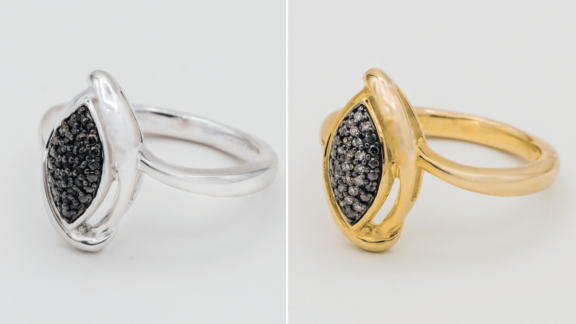What is Rhodium Plating?
Written by Annabelle
April 1, 2019

You're shopping online, just browsing through jewelry, and the term “rhodium plating” catches your eye. What is that? And why is it over metals like white gold and sterling silver? These are questions that we're ready to answer below.
Rhodium
Rhodium is the 45th element on the periodic table; it's a silvery-white metal that's very hard and durable, and never tarnishes or corrodes. Because of its qualities, it's used as a coating in several industries, including fine jewelry. Its rarity, high melting point, and low malleability makes it unsuitable for actual jewelry manufacturing; it's very costly to make solid rhodium jewelry.
White Gold and Sterling Silver

A vintage white gold ruby and diamond ring showing discoloration and after plating.
The two metals that rhodium is commonly applied to are white gold and sterling silver.
- White Gold: Contrary to popular belief, white gold isn't another “type” of gold. Gold, as an element, naturally occurs in only one form- yellow. White gold is actually a commercial alloy made from a combination of gold and one other white-colored metal, such as nickel, silver, or palladium. As a result, it's actually off-white. The signature color of white gold comes from the coating of rhodium applied to it before it goes on the market. Rhodium plating white gold is a standard procedure in the jewelry industry.
- Sterling Silver: Sterling silver is another alloy that consists of 92.5% silver and 7.5% other metal, such as copper. It's prone to tarnish over time, caused by the exposure to sulfur in the air, which forms dark silver sulfide on the surface. Since rhodium does not tarnish, it's plated over silver in order to preserve the silvery-white look and prevent it from darkening over time.
The Process Of Rhodium Plating:
The plating process is a complex procedure that involves precision and a lot of interesting chemistry.

Rhodium Plating Other Metals
Aside from sterling silver and white gold, it's possible to plate other metals. Yellow gold and rose gold are easy to plate; some individuals grow tired of their item's original color and will opt to make a switch. However, non-precious metals such as miscellaneous alloys, copper, and brass are much more difficult to plate because of their chemical composition. In order to plate jewelry made from those materials, the item will need a preliminary coating of another metal, such as nickel, in order to make it ready for the plating process.

This client's ring was swapped from a yellow gold look to a shiny white gold aesthetic.
Rhodium Plating Details
Sometimes rhodium isn't applied to the whole piece. This is common in two-tone jewelry, where parts of the design are yellow and other details are white. In most situations, rhodium is applied to the prongs, often to give diamonds the illusion of a bigger stone or cleaner setting.

A two-tone ring with rhodium on the exterior
Now you're up-to-date on rhodium plating! If you're looking to brighten up your jewelry, check out our rhodium plating service below.




